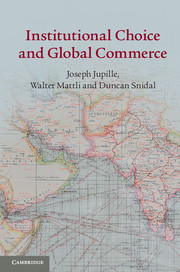Book contents
- Frontmatter
- Contents
- List of figures
- List of tables
- Acknowledgements
- Part I
- Part II
- 4 Creating the first international court of commercial dispute resolution
- 5 Commercial complexity and institutional choice in the GATT era
- 6 Institutional choice in global accounting governance
- Part III
- Bibliography
- Index
5 - Commercial complexity and institutional choice in the GATT era
Published online by Cambridge University Press: 05 June 2014
- Frontmatter
- Contents
- List of figures
- List of tables
- Acknowledgements
- Part I
- Part II
- 4 Creating the first international court of commercial dispute resolution
- 5 Commercial complexity and institutional choice in the GATT era
- 6 Institutional choice in global accounting governance
- Part III
- Bibliography
- Index
Summary
Introduction
In Chapter 3, we examined postwar institutional choices in global commerce at the level of macro architecture: why did the ITO fail, the GATT succeed, and the WTO emerge? This allowed us to tell the important story of the postwar trade regime in terms of our USCC theory of boundedly rational institutional choice, although we did not present it as a strong and independent test because it is so familiar that it implicitly informed our theory construction. We then addressed the Mixed Courts of Egypt, which departed from an institutional status quo that was massively deficient relative to the cooperation problem posed by the first great wave of globalization. In both cases, our approach explains institutional Creation, which only occurs when circumstances make existing institutional alternatives deeply unattractive, and which characteristically unfolds relatively slowly. And in both cases the new status quo exerted a strong and enduring pull. It took nearly fifty years for states to transform the GATT into the WTO, even though the latter had a superior design for managing global trade. Similarly, the Mixed Courts of Egypt were widely and extensively Used for a half-century, and underwent only the most modest Change, even in the face of systemic rupture.
This chapter begins with the relatively placid institutional status quo established by the Creation of the General Agreement on Tariffs and Trade (GATT) in 1947 and examines institutional choices during the period in which this accidental institution “was virtually coterminous” with the global trade regime. Throughout the period, the General Agreement inarguably stood at the center of the institutional status quo for trade. Yet its focalness, the existence (and appeal) of alternative institutional arrangements, and the nature of the issues facing states all vary over time and across sets of actors and issues.
- Type
- Chapter
- Information
- Institutional Choice and Global Commerce , pp. 132 - 164Publisher: Cambridge University PressPrint publication year: 2013



